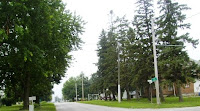
In the early 1900s, Iowa roads were horrible, not much better than wagon ruts. They were impassable for weeks at a time due to snow and mud. During rainy times or heavy snow and melting, farmers couldn’t get to market, no one could get to the rails, the mail sat undelivered for weeks at a time. In 1910 Governor Carroll called for a Good Roads Convention in Des Moines. It was decided that a River-to-River Road from Davenport to Council Bluffs would benefit Iowa. People were traveling more with the growing popularity of the automobile.

Iowa then made history and set a record in road building when ten thousand farmers engaged in building a 380 mile River to River Road out of existing lines of dirt road in one hour flat and not one of them received a penny for his service.

(NOTE: Great part of the state for wind turbines!)
About the same time, small towns between Atlantic, IA and Des Moines had been busy building and promoting a road through their towns that would be less hilly, straighter and shorter than the northern section of the River to River.
In 1910, the original White Pole Road followed the Chicago, Rock Island and Pacific Railroad from Des Moines to Council Bluffs. Early roadways did not receive government funding. It was up to the people to maintain their road in order to attract more business to their communities. Poles along the route were painted white and auto tourists were encouraged to travel the "Great White Way".

In the fall of 1912, the road was extended east from Des Moines to Davenport. In 1913 the Iowa Highway Commission through the Iowa Highway Route Registration Act had the job of registering trails that were more than 25 miles long. October 6, 1913, The Great White Way Association applied for registration and paid the $5 fee. On July 20, 1914, the association was awarded a certificate making it the first certified route under the provisions of the State Highway Commission's rules.
In 1922, the Great White Way Highway merged with the River-to-River Road and over the years merged with more roadways. In December of 1931, sections of the White Pole Road officially became a part of U.S. Highway 6, which at one point was the longest continuous east-west route in the United States stretching from Cape Cod, Massachusetts to Long Beach, California.
In 1947, Highway 6 officially became the Grand Army of the Republic Highway, as a tribute to Union veterans of the Civil War. In 1965, Interstate 80 was completed and the importance of this east-west highway diminished. By 2003, to save the state some money, a section of highway was renumbered 925 and given to the area counties for maintenance and upkeep. That is full circle – back to the care and nurturing of the residents. It was officially renamed the White Pole Road. Poles along this 26-mile stretch have been painted white and once again it's up to the people to maintain the road and grow their communities.

It's the people who built the original road and today it's the people building it again with tradition and spirit.















No comments:
Post a Comment